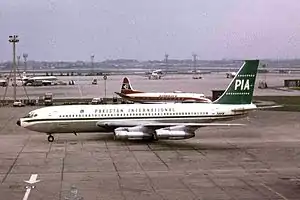1981 Pakistan International Airlines hijacking
In March 1981, the militant insurgency group, Al-Zulfiqar, led by Murtaza Bhutto, hijacked Pakistan International Airlines flight PK-326. The hijacking went on for thirteen days, starting on the 2nd of March, and ending on the 15th. It was a routine flight scheduled from Karachi to Peshawar, but the hijackers diverted it to Kabul, Afghanistan, and then Damascus. They eventually got off at Damascus.
 A Pakistan International Airlines Boeing 720 similar to the hijacked aircraft | |
| Incident | |
|---|---|
| Date | 2 March 1981 |
| Summary | Hijacking |
| Site | en route |
| Aircraft | |
| Aircraft type | Boeing 720 |
| Operator | Pakistan International Airlines |
| Registration | PK-326 |
| Flight origin | Karachi |
| Stopover | Kabul (1st diversion) |
| 1st stopover | Damascus (2nd diversion) |
| Destination | Peshawar |
| Passengers | 135 (inc. 3 terrorists) |
| Crew | 9 |
| Fatalities | 1 |
| Injuries | 0 |
| Survivors | 143 |
Members of Al-Zulfiqar and the student wing of Pakistan People’s Party, PSF, hijacked the plane, and demanded the release of 54 political prisoners. Some passengers were let off, but others were not. This included Major Tariq Rahim, who Murtaza felt had abandoned his father Zulfiqar Ali Bhutto. The Pakistani diplomat was shot, and his body was thrown onto the tarmac. At first, the Zia-ul-Haq regime was hesitant, and wanted to resist this threat. However, they eventually gave in, and released more than 50 prisoners, which included members of PPP, PSF, and NSF.
Al-Zulfiqar and PSF activist Salamullah Tipu along with three other PSF militants hijacked the plane. The plane was first forced to land at Kabul airport, and was then flown to Damascus. Although undertaken to 'avenge Zulfiqar Ali Bhutto's hanging by Zia', the hijacking was at once condemned by the young co-chairperson of the PPP, Benazir Bhutto, who was languishing in a Karachi jail.
The hijackers demanded that 54 political prisoners be released. These included PPP, PSF, NSF and some Marxist Jiyala activists. Zia-ul-Haq hesitated and Tipu shot dead Captain Tariq Rahim, whom he mistakenly believed to be the son of then-martial law administrator General Rahimuddin Khan on the plane accusing him of being a part of Zia's coup against Bhutto. He wasn't.
Around 50 prisoners were eventually released by the Zia-ul-Haq regime. Tipu was thrown in a Kabul prison and eventually executed in 1984 for murdering an Afghan national. His body was never returned, and he is said to have been buried somewhere near Kabul.
The successful hijacking not only saw many of the released men join AZO, but the organization also welcomed a whole new batch of recruits who travelled across Pakistan's tribal areas and entered Afghanistan.
AZO described itself as a socialist guerrilla outfit, but its main purpose was avenging Bhutto's death. The organization was mostly made up of young PSF militants, and members of small left-wing groups such as the Communist Mazdoor Kissan Party.[1]
One of the three American hostages on the flight, Fred Hubbell, ran for the position of governor of the state of Iowa in the 2018 election.[2]
References
- Paracha, Nadeem F. (2010-04-09). "Al-Zulfikar: The unsaid history". DAWN.COM. Retrieved 2021-02-01.
- Tanner, Henry (1981-03-15). "PLANE HIJACKERS SURRENDER IN SYRIA, ENDING 13-DAY ORDEAL FOR HOSTAGES". The New York Times. ISSN 0362-4331. Retrieved 2018-07-11.